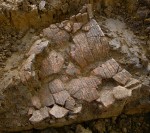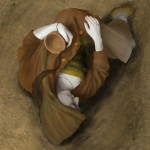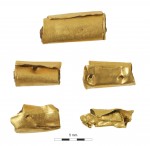 Archaeological from Wessex Archaeology excavating a gravel quarry in Berkshire discovered a rare 4,400-year-old Beaker burial 18 months ago. The news was kept under embargo until Friday to give the team time to analyze the bones and grave goods, both of which make the grave even more rare: beads made of folded sheet gold and the likelihood that the person buried was female.
Archaeological from Wessex Archaeology excavating a gravel quarry in Berkshire discovered a rare 4,400-year-old Beaker burial 18 months ago. The news was kept under embargo until Friday to give the team time to analyze the bones and grave goods, both of which make the grave even more rare: beads made of folded sheet gold and the likelihood that the person buried was female.
 Beaker burials — Copper Age graves from around 2,500 B.C. characterized by the ritual inclusion of a fine pottery drinking vessel known as a beaker — are extremely rare in south-east England. Gold has only been found in a small fraction of the already small number of Beaker burials, and those graves held male skeletons. Only the most important people in Beaker society were buried with gold and they were not surprisingly male.
Beaker burials — Copper Age graves from around 2,500 B.C. characterized by the ritual inclusion of a fine pottery drinking vessel known as a beaker — are extremely rare in south-east England. Gold has only been found in a small fraction of the already small number of Beaker burials, and those graves held male skeletons. Only the most important people in Beaker society were buried with gold and they were not surprisingly male.
 Although researchers were not able to confirm this with complete certainty due to damage to the bone caused by the acidic soil which makes radiocarbon dating and DNA testing impossible, osteological examination indicates the skeleton is that of a woman who was at least 35 years of age when she died. The gold from Beaker burials is some of the earliest gold ornamentation discovered in England, and this is the earliest known woman in England to have been found buried with gold.
Although researchers were not able to confirm this with complete certainty due to damage to the bone caused by the acidic soil which makes radiocarbon dating and DNA testing impossible, osteological examination indicates the skeleton is that of a woman who was at least 35 years of age when she died. The gold from Beaker burials is some of the earliest gold ornamentation discovered in England, and this is the earliest known woman in England to have been found buried with gold.
 She was buried in high style. Five tubular (80s flashback!) beads made from folded pieces of sheet gold were found, once part of a necklace. Black disc beads of a jet-like material called lignite were also part of the necklace. Archaeologists found thirty lignite beads and 29 fragments of amber beads, so this was an elaborate necklace indeed. Lignite beads were also discovered near her hand, perhaps from a matching bracelet.
She was buried in high style. Five tubular (80s flashback!) beads made from folded pieces of sheet gold were found, once part of a necklace. Black disc beads of a jet-like material called lignite were also part of the necklace. Archaeologists found thirty lignite beads and 29 fragments of amber beads, so this was an elaborate necklace indeed. Lignite beads were also discovered near her hand, perhaps from a matching bracelet.
 Larger perforated amber rounds were found in a row down her body. They were probably extremely fancy, extremely expensive buttons going down the front a Copper Age version of a cardigan.
Larger perforated amber rounds were found in a row down her body. They were probably extremely fancy, extremely expensive buttons going down the front a Copper Age version of a cardigan.
Lastly, a large pottery beaker with nicely even stripes probably applied using a comb-like stamp was placed on her hip, an unusual position for the beaker in the Beaker burials. They are usually found by the feet or shoulders.
All of this elegance and quality strongly suggests the woman was someone of impeccably high status.
Archaeologist Gareth Chaffey of Wessex Archaeology, who is directing the ongoing excavation, said that the woman unearthed at the site “was probably an important person in her society, perhaps holding some standing which gave her access to prestigious, rare and exotic items. She could have been a leader, a person with power and authority, or possibly part of an elite family – perhaps a princess or queen.”
Lead isotope analysis performed on the gold found that it was mined in south-east Ireland and southern Britain. The lignite beads are from Eastern England and the amber buttons probably from the Baltic, although it may have been local amber found on beaches. Scientists hope that further analysis will answer some questions about how the gold was procured and traded along existing trade routes.
This find is not the only significant discovery achaeologists have made since they began excavating Kingsmead Quarry in 2003. During the Copper Age and for thousands of years after that, the quarry was in a floodplain on the shore of the Thames. Its convenient access to water ensure it was inhabited by many subsequent generations. The excavations have found evidence of human occupation steadily from the Palaeolithic to the Middle Ages.
The quarry is owned by the CEMEX building materials company. They have funded the ongoing excavation to the tune of £4 million ($6,000,000), and it certainly had paid off in terms discoveries. More than 28 hectares of the quarry have been excavated now. There are ancient artifacts, Neolithic houses, entire landscapes that have been exposed to expert eye. The plan is to continue digging for another two years.
Wessex Archaeology and CEMEX will be displaying some of the discoveries, including the gold beads, at an event at Wraysbury Village Hall, Berkshire, on Saturday April 27th between 10.30 AM and 3.30 PM. Admission is free. Visitors not only get to see the artifacts in person, but they also get to meet the archaeologists working on the project and examine a skeleton.
They hope to have the Beaker artifacts on display in a museum by the end of the year.